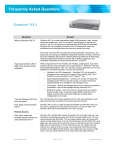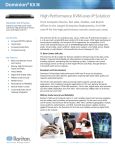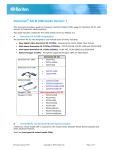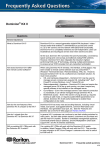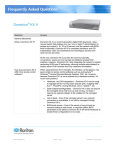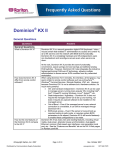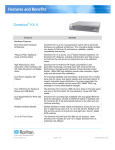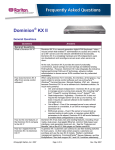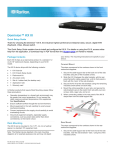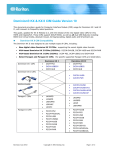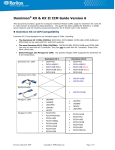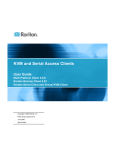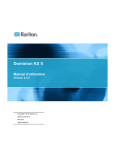Download Dominion® KX
Transcript
Dominion KX III – Frequently Asked Questions Frequently Asked Questions Dominion® KX III Question What is Dominion KX III? Answer Dominion KX III is a third-generation digital KVM (keyboard, video, mouse) switch that enables one, two, four or eight IT administrators to access and control 8, 16, 32 or 64 servers over the network with BIOS-level functionality. Dominion KX III is completely hardware- and OS-independent; users can troubleshoot and reconfigure servers even when servers are down. At the rack, Dominion KX III provides the same functionality, convenience, and space and cost savings as traditional analog KVM switches. However, Dominion KX III also integrates the industry’s highest performing KVM-over-IP technology, allowing multiple administrators to access server KVM consoles from any ® ® networked workstation as well as from the iPhone and iPad . How is KX III different from KXII? The KX III is the next generation version of the KX II. Featuring a modern hardware design with increased computing power and storage, the KX III provides KVM-over-IP access for IT administration, as well as high performance IP access for broadcast applications. KX III includes virtually all KX II features with the following advancements: The KX III's new video processing engine supports a broad range of applications from traditional computer applications to the most dynamic broadcast applications requiring 30 frames-per-second 1920x1080 video, 24 bit color, digital audio, dual monitors and DVI, HDMI, DisplayPort and VGA video. With the industry’s first DVI-based local port, the KX III's common user interface provides new levels of productivity and performance for at-the-rack administration and server access. All KX III models feature a tiering port to connect multiple Dominion KX III switches together and access the attached servers. Up to 1024 servers can be accessed via a consolidated port list. KX III supports all Dominion and Paragon II CIMs supported by KX II. Can the Dominion KX III be rack mounted? Yes. The Dominion KX III ships standard with 19" rack mount brackets. It can also be reverse rack mounted so the server ports face forward. How large is the Dominion KX III? The Dominion KX III models fit in a standard 19" rack. The Dominion KX III 64 port models are 2U high and are 13.3" deep. All other models are 1U high and are 13.15" deep. Remote Access How many users can remotely access servers on each Dominion KX III? © 2014 Raritan Inc. Dominion KX III models offer remote connections for up to eight users per user channel to simultaneously access and control a unique target server. For onechannel devices like the DKX3-116, up to eight remote users can access and control a single target server. For two-channel devices, like the DKX3-216, up to eight users can access and control the server on channel one and up to another eight users on channel two. For four-channel devices, up to eight users per channel, for a total of 32 (8 x 4) users, can access and control four servers. Likewise, for the eight-channel devices, up to eight users can access a single server, up to an overall maximum of 32 users across the eight channels. Page 1 of 16 V1176 January 2014 Dominion KX III – Frequently Asked Questions Can I remotely access servers from my iPhone or iPad? Yes. Users can access servers connected to the KX III using their iPhone or iPad. Command Center Secure Gateway is required. Can two people look at the same server at the same time? Yes. Actually, up to eight people can access and control any single server at the same time. Can two people access the same server, one remotely and one from the local port? Yes. The local port is completely independent of the remote “ports.” The local port can access the same server using the PC-Share feature. In order to access Dominion KX III from a client, what hardware, software or network configuration is required? Because Dominion KX III is completely Web-accessible, it doesn’t require customers to install proprietary software on clients used for access. Dominion KX III can be accessed through major Web browsers, including: ® ® Internet Explorer and Firefox . Dominion KX III can be accessed on Windows, ® Linux and Macintosh desktops, via Raritan’s Active KVM Windows Client, and the Java™-based Virtual KVM Client™. Dominion KX III administrators can also perform remote management (set passwords and security, rename servers, change IP address, etc.) using a convenient browser-based interface. What is the file size of the applet that’s used to access Dominion KX III? How long does it take to retrieve? The Virtual KVM Client (VKC) applet used to access Dominion KX III is approximately 500KB in size. The following chart describes the time required to retrieve Dominion KX III’s applet at different network speeds: 100Mbps Theoretical 100Mbit network speed .05 seconds 60Mbps Likely practical 100Mbit network speed .08 seconds 10Mbps Theoretical 10Mbit network speed .4 seconds 6Mbps Likely practical 10Mbit network speed .8 seconds 512Kbps Cable modem download speed (typical) 8 seconds How do I access servers connected to Dominion KX III if the network ever becomes unavailable? You can access servers at the rack or via modem. Do you have a Windows KVM Client? Yes. We have a native .NET Windows Client called the Raritan Active KVM Client (AKC). Do you have a nonWindows KVM Client? Yes. The Virtual KVM Client (VKC) allows non-Windows users to connect to target servers in the data center. Please refer to Raritan’s Dominion KX III and KVM Client User Guides for more information. Do your KVM Clients have multi-language support? Yes. The Dominion KX III’s remote HTML User Interface and the KVM Clients support the Japanese, Simplified Chinese and Traditional Chinese languages. This is available stand-alone as well as through CC-SG. Do your KVM Clients support dual LCD monitors? Yes. For customers wishing to enhance their productivity by using multiple LCD monitors on their desktops, the Dominion KX III can launch KVM sessions to multiple monitors, either in full screen or standard modes. Do you support servers with dual video cards? Yes, servers with dual video cards are supported with an extended desktop configuration available to the remote user. Dominion KX III offers a dedicated modem port for attaching an external modem. TM Universal Virtual Media © 2014 Raritan Inc. Page 2 of 16 V1176 January 2014 Dominion KX III – Frequently Asked Questions Which Dominion KX III models support virtual media? All Dominion KX III models support virtual media. It is available stand-alone and ® through CommandCenter Secure Gateway, Raritan’s centralized management appliance. Which types of virtual media does the Dominion KX III support? Dominion KX III supports the following types of media: internal and USBconnected CD/DVD drives, USB mass storage devices, PC hard drives and ISO images. What is required for virtual media? A Dominion KX III virtual media CIM is required. There are two VGA-based CIMs: the D2CIM-VUSB and the D2CIM-DVUSB. The D2CIM-VUSB has a single USB connector and is for customers who will use virtual media at the OS level. The D2CIM-DVUSB has dual USB connectors and should be purchased by customers who wish to utilize virtual media at the BIOS level. The D2CIMDVUSB is also required for smart card authentication, tiering/cascading and digital audio. Both support virtual media sessions to target servers supporting the USB 2.0 interface. Available in economical 32 and 64 quantity CIM packages, these ™ CIMs support Absolute Mouse Synchronization as well as remote firmware updates. Our CIMs have traditionally supported analog VGA video. Three new dual virtual media CIMs support digital video formats, including DVI, HDMI and DisplayPort. These are the D2CIM-DVUSB-DVI, D2CIM-DVUSB-HDMI and D2CIM-DVUSB-DP. Is virtual media secure? Yes. Virtual media sessions are secured using 256-bit AES, 128-bit AES or 128bit RC4 encryption. Does virtual media really support audio? Yes. Audio playback and recording to a server connected to the Dominion KX III is supported. You can listen to sounds and audio playing on a remote server in the data center using the speakers connected to your desktop PC or laptop. You can also record on the remote server using a microphone connected to your PC or laptop. The D2CIM-DVUSB dual virtual media CIM is required. What is a USB profile? Certain servers require a specifically configured USB interface for USB-based services such as virtual media. The USB profile tailors the KX III’s USB interface to the server to accommodate these server-specific characteristics. Why would I use a USB profile? USB profiles are most often required at the BIOS level where there may not be full support for the USB specification when accessing virtual media drives. However, profiles are sometimes used at the OS level, for example, for mouse synchronization for Macintosh and Linux servers. How is a USB profile used? Individual ports or groups of ports can be configured by the administrator to use a specific USB profile in the KX III’s port configuration page. A USB profile can also be selected in the KX III Client when required. See the user guide for more information. Do I always need to set a USB profile when I use virtual media? No. In many cases, the default USB profile is sufficient when using virtual media at the OS level or operating at the BIOS level without accessing virtual media. © 2014 Raritan Inc. Page 3 of 16 V1176 January 2014 Dominion KX III – Frequently Asked Questions What profiles are available? Where can I find more information? Consult the user guide for the available profiles and for more information. Bandwidth and KVM-over-IP Performance How is bandwidth used in KVM-over-IP systems? Dominion KX III offers third-generation KVM-over-IP technology – totally new video processing that provides flexible, high performance video, efficient use of bandwidth and anytime/anywhere access via LAN, WAN or Internet. The Dominion KX III digitizes compresses and encrypts the keyboard, video and mouse signals from the target server and transmits IP packets over the IP network to the remote KVM client to create the remote session to the user. The KX III provides an at-the-rack experience based on its industry-leading video processing algorithms. Screen changes, i.e., video accounts for the majority of the bandwidth used – and keyboard and mouse activity are significantly less. It is important to note that bandwidth is only used when the user is active. The amount of bandwidth used is based on the amount of change to the server’s video display screen. If there are no changes to the video — the user is not interacting with the server — there is generally little or no bandwidth used. If the user moves the mouse or types a character, then there is a small amount of bandwidth used. If the display is running a complex screen saver or playing a video, then there can be a larger amount of bandwidth used. How does bandwidth affect KVM-over-IP performance? In general, there is a trade-off between bandwidth and performance. The more bandwidth available, the better performance can be. In limited bandwidth environments, performance can degrade. The Dominion KX III has been optimized to provide strong performance in a wide variety of environments. What factors affect bandwidth? There are many factors that determine how much bandwidth will be used. The primary factor, noted above, is the amount of change in the target server’s video display. This is dependent on the user’s task and actions. Other factors include the server’s video resolution, networking speed and characteristics, client PC resources and video card noise. How much bandwidth does KX III use for common tasks? © 2014 Raritan Inc. Bandwidth primarily depends on the user’s task and actions. The more the server’s video screen changes, the more bandwidth is utilized. Page 4 of 16 V1176 January 2014 Dominion KX III – Frequently Asked Questions How do I optimize performance and bandwidth? KX III provides a variety of settings in our remote clients for the user to optimize bandwidth and performance. The default settings will provide an at-the-rack level of performance in standard LAN/WAN environments with economical use of bandwidth. The Connection Properties dialog box can be used to manage the trade off between video quality and low bandwidth. With three simple settings you can operate in a wide variety of environments. Optimize For. Use this setting to configure the video engine for standard IT/computer applications or for video/broadcast applications. Video Mode. Move the slider to the left for the highest possible video quality and to the right for the least amount of bandwidth. Noise Filter. In most cases, the default setting will work best, however you can move to the left for more responsive video and to the right for lower bandwidth. For slow Internet connections, the use of 8-bit color or lower bit depths can reduce bandwidth and improve performance. Other tips to decrease bandwidth include: • Use a solid desktop background instead of a complex image • Disable screensavers • Use a lower video resolution on the target server • Uncheck the “Show window contents while dragging” option in Windows • Use simple images, themes and desktops (e.g., Windows Classic) I want to connect over the Internet. What type of performance should I expect? It depends on the bandwidth and latency of the Internet connection between your remote client and the KX III. With a cable modem or high speed DSL connection, your performance can be very similar to a LAN/WAN connection. For lower speed links, use the suggestions above to improve performance. I have a high bandwidth environment. How can I optimize performance? The default settings will work well. You can move the Connection Properties settings to the left for increased video performance. What is the maximum remote (over IP) video resolution supported? The Dominion KX III is the first and only KVM-over-IP switch to support full high definition (HD) remote video resolution — 1920x1080 at frame rates up to 30 frames per second with digital audio. In addition, popular widescreen formats are supported, including 1600x1200, 1680x1050 and 1440x900, so remote users can work with today’s higher resolution monitors. How much bandwidth is used for audio? It depends on the type of audio format used, but to listen to CD quality audio, approximately 1.5 Mbps is used. What about servers with DVI ports? Servers with DVI ports that support DVI-A (analog) and DVI-I (integrated analog and digital) can use Raritan’s ADVI-VGA inexpensive, passive adapter to convert the server’s DVI port to a VGA plug that can be connected to a KX III CIM’s VGA plug. Servers with DVI ports that support DVI-I or DVI-D (digital) can use the D2CIMDVUSB-DVI CIM. © 2014 Raritan Inc. Page 5 of 16 V1176 January 2014 Dominion KX III – Frequently Asked Questions Ethernet and IP Networking What is the speed of Dominion KX III’s Ethernet interfaces? Dominion KX III supports gigabit as well as 10/100 Ethernet. KX III supports two 10/100/1000 speed Ethernet interfaces, with configurable speed and duplex settings (either auto detected or manually set). Can I access Dominion KX III over a wireless connection? Yes. Dominion KX III not only uses standard Ethernet, but also very conservative bandwidth with very high quality video. Thus, if a wireless client has network connectivity to a Dominion KX III, servers can be configured and managed at the BIOS level wirelessly. Does the Dominion KX III offer dual gigabit Ethernet ports to provide redundant failover or load balancing? Yes. Dominion KX III features dual gigabit Ethernet ports to provide redundant failover capabilities. Should the primary Ethernet port (or the switch/router to which it is connected) fail, Dominion KX III will failover to the secondary network port with the same IP address – ensuring that server operations are not disrupted. Note that automatic failover must be enabled by the administrator. Can I use Dominion KX III with a VPN? Yes. Dominion KX III uses standard Internet Protocol (IP) technologies from Layer 1 through Layer 4. Traffic can be easily tunneled through standard VPNs. Can I use KX III with a proxy server? Yes. KX III can be used with a SOCKS proxy server, assuming the remote client PC is configured appropriately. Contact the user documentation or online help for more information. How many TCP ports must be open on my firewall in order to enable network access to Dominion KX III? Two ports are required: TCP port 5000 to discover other Dominion devices and for communication between Raritan devices and CC-SG; and, of course, port 443 for HTTPS communication. Are these ports configurable? Yes. Dominion KX III’s TCP ports are configurable by the administrator. Can Dominion KX III be ® used with Citrix ? Dominion KX III may work with remote access products like Citrix if configured appropriately, but Raritan cannot guarantee it will work with acceptable performance. Customers should realize that products like Citrix utilize video redirection technologies similar in concept to digital KVM switches so that two KVM-over-IP technologies are being used simultaneously. Can the Dominion KX III use DHCP? DHCP addressing can be used; however, Raritan recommends fixed addressing since the Dominion KX III is an infrastructure device and can be accessed and administered more effectively with a fixed IP address. I’m having problems connecting to the Dominion KX III over my IP network. What could be the problem? The Dominion KX III relies on your LAN/WAN network. Some possible problems include: © 2014 Raritan Inc. • Ethernet auto-negotiation. On some networks, 10/100 autonegotiation does not work properly, and the Dominion KX III unit must be set to 100 Mb/full duplex or the appropriate choice for its network. • Duplicate IP address. If the IP address of the Dominion KX III is the same as another device, network connectivity may be inconsistent. • Port 5000 conflicts. If another device is using port 5000, the Dominion KX III default port must be changed (or the other device must be changed). • When changing the IP address of a Dominion KX III, or swapping in a new Dominion KX III, sufficient time must be allowed for its IP and ® Mac addresses to be known throughout the Layer 2 and Layer 3 networks. Page 6 of 16 V1176 January 2014 Dominion KX III – Frequently Asked Questions IPv6 Networking What is IPv6? IPv6 is the acronym for Internet Protocol Version 6. IPv6 is the “next generation” IP protocol which will replace the current IP Version 4 (IPv4) protocol. IPv6 addresses a number of problems in IPv4, such as the limited number of IPv4 addresses. It also improves IPv4 in areas such as routing and network auto-configuration. IPv6 is expected to gradually replace IPv4, with the two coexisting for a number of years. IPv6 treats one of the largest headaches of an IP network from the administrator’s point of view – configuring and maintaining an IP network. Why does Dominion KX III support IPv6 networking? U.S. government agencies and the Department of Defense are now mandated to purchase IPv6-compatible products. In addition, many enterprises and foreign countries, such as China, will be transitioning to IPv6 over the next several years. What is “dual stack” and why is it required? Dual stack is the ability to simultaneously support both IPv4 and IPv6 protocols. Given the gradual transition from IPv4 to IPv6, dual stack is a fundamental requirement for IPv6 support. How do I enable IPv6 on the Dominion KX III? Use the “Network Settings” page, available from the “Device Settings” tab. Enable IPv6 addressing and choose manual or auto-configuration. Consult the user guide for more information. What if I have an external server with an IPv6 address that I want to use with my Dominion KX III? The Dominion KX III can access external servers via their IPv6 addresses, for example, an SNMP manager, syslog server or LDAP server. Using the Dominion KX III’s dual-stack architecture, these external servers can be accessed via: (1) an IPv4 address, (2) IPv6 address or (3) hostname. So, the Dominion KX III supports the mixed IPv4/IPv6 environment many customers will have. What if my network doesn’t support IPv6? The Dominion KX III’s default networking is set at the factory for IPv4 only. When you are ready to use IPv6, then follow the above instructions to enable IPv4/IPv6 dual-stack operation. Where can I get more information on IPv6? See www.ipv6.org for general information on IPv6. The Dominion KX III user guide describes the Dominion KX III’s support for IPv6. Servers Does Dominion KX III depend on a Windows server to operate? Absolutely not. Because users depend on the KVM infrastructure to always be available in any scenario whatsoever (as they will likely need to use the KVM infrastructure to fix problems), Dominion KX III is designed to be completely independent from any external server. What should I do to prepare a server for connection to Dominion KX III? Set the mouse parameter options to provide users with the best mouse synchronization and turn off screensavers and any power management features that affect screen display. What about mouse synchronization? In the past, KVM-over-IP mouse synchronization was a frustrating experience. The Dominion KX III’s Absolute Mouse Synchronization provides for a tightly synchronized mouse without requiring server mouse setting changes on ® Windows and Apple Mac servers. For other servers, the Intelligent Mouse mode or the speedy, single mouse mode can be used to avoid changing the server mouse settings. What comes in the Dominion KX III box? The following is included: (1) Dominion KX III unit, (2) Quick Setup Guide, (3) standard 19" rack mount brackets, (4) user manual CD-ROM, (5) localized AC line cord and (6) warranty certificate and other documentation. © 2014 Raritan Inc. Page 7 of 16 V1176 January 2014 Dominion KX III – Frequently Asked Questions Blade Servers Can I connect blade servers to the Dominion KX III? Yes. Dominion KX III supports popular blade server models from the leading ® ® ® ® blade server manufacturers: HP , IBM , Dell and Cisco . Which blade servers are supported? The following models are supported: Dell PowerEdge 1855, 1955 and M1000e; ® HP BladeSystem c3000 and c7000; IBM BladeCenter H, E and S; and Cisco UCS B-Series. Which CIM should I use? It depends on the type of KVM ports on the specific make and model of the blade server you are using. The following CIMs are supported: DCIM-PS2, DCIM-USBG2, D2CIM-VUSB and D2CIM-DVUSB. Which types of access and control are available? The Dominion KX III provides automated and secure KVM access: (1) at the rack, (2) remotely over IP, (3) via CommandCenter and (4) by modem. Do I have to use hotkeys to switch between blades? Some blade servers require you to use hotkeys to switch between blades. With the Dominion KX III, you don’t have to use these hotkeys. Just click on the name of the blade server, and the Dominion KX III will automatically switch to that blade without the explicit use of the hotkey. Can I access the blade server’s management module? Yes. You can define the URL of the management module and access it from the Dominion KX III or from our CommandCenter Secure Gateway. If configured, one-click access is available. How many blade servers can I connect to a Dominion KX III? For performance and reliability reasons, you can connect up to eight blade chassis to a Dominion KX III, regardless of model. Raritan recommends connecting up to two times the number of remote connections supported by the device. For example, with a KX3-216 with two remote channels, we recommend connecting up to four blade server chassis. You can, of course, connect individual servers to the remaining server ports. I’m an enterprise customer using CommandCenter Secure Gateway. Can I access blade servers via CommandCenter Secure Gateway? Yes. Once blade servers are configured on the Dominion KX III, the CommandCenter Secure Gateway user can access them via KVM connections. In addition, the blade servers are organized by chassis as well as CommandCenter Secure Gateway custom views. What if I also want in-band or embedded KVM access? In-band and embedded access to blade servers can be configured within CommandCenter Secure Gateway. ® ® I’m running VMware on some of my blade servers. Is this supported? Yes. With CommandCenter Secure Gateway, you can display and access virtual machines running on blade servers. Is virtual media supported? This depends on the blade server. HP blades can support virtual media. The IBM BladeCenter (except for BladeCenter T) supports virtual media if configured appropriately. A virtual media CIM – D2CIM-VUSB or D2CIM-DVUSB – must be used. Is Absolute Mouse Synchronization supported? Servers with internal KVM switches inside the blade chassis typically do not support absolute mouse technology. For HP blade and some Dell blade servers, a CIM can be connected to each blade, so Absolute Mouse Synchronization is supported. Is blade access secure? Yes. Blade access uses all of the standard Dominion KX III security features such as 128-bit or 256-bit encryption. In addition, there are blade-specific security features such as per blade access permissions and hotkey-blocking that eliminates unauthorized access. Does the Dominion KSX II or the KX II-101 support blade servers? At this time, these products do not support blade servers. © 2014 Raritan Inc. Page 8 of 16 V1176 January 2014 Dominion KX III – Frequently Asked Questions Installation Besides the unit itself, what do I need to order from Raritan to install Dominion KX III? Each server that connects to Dominion KX III requires a Dominion or Paragon computer interface module (CIM), an adapter that connects directly to the keyboard, video and mouse ports of the server. Which kind of Cat5 cabling should be used in my installation? Dominion KX III can use any standard UTP (unshielded twisted pair) cabling, whether Cat5, Cat5e or Cat6. Often in our manuals and marketing literature, Raritan will simply say “Cat5” cabling for short. In actuality, any brand UTP cable will suffice for Dominion KX III. Which types of servers and PCs can be connected to Dominion KX III? Dominion KX III is completely vendor independent. Any server with standardscompliant keyboard, video and mouse ports can be connected. In addition, servers with serial ports can be controlled using the P2CIM-SER CIM. How do I connect servers to Dominion KX III? Servers that connect to the Dominion KX III require a Dominion or Paragon CIM, which connects directly to the keyboard, video and mouse ports of the server. Then, connect each CIM to Dominion KX III using standard UTP (unshielded twisted pair) cable such as Cat5, Cat5e or Cat6. How far can my servers be from Dominion KX III? In general, servers can be up to 150 feet (45 m) away from Dominion KX III, depending on the type of server. (See user manual or help on the Raritan website.) For the D2CIM-VUSB CIMs that supports virtual media and Absolute Mouse Synchronization, a 100-foot (30 m) range is recommended. Some operating systems lock up when I disconnect a keyboard or mouse during operation. What prevents servers connected to Dominion KX III from locking up when I switch away from them? Each Dominion computer interface module (DCIM) dongle acts as a virtual keyboard and mouse to the server to which it is connected. This technology is called KME (keyboard/mouse emulation). Raritan’s KME technology is data center grade, battle-tested and far more reliable than that found in lower-end KVM switches: it incorporates more than 15 years of experience and has been deployed to millions of servers worldwide. Are there any agents that must be installed on servers connected to Dominion KX III? Servers connected to Dominion KX III do not require any software agents to be installed because Dominion KX III connects directly via hardware to the servers’ keyboard, video and mouse ports. How many servers can be connected to each Dominion KX III unit? Dominion KX III models range from 8, 16 or 32 server ports in a 1U chassis, to 64 server ports in a 2U chassis. This is the industry’s highest digital KVM switch port density. What happens if I disconnect a server from Dominion KX III and reconnect it to another Dominion KX III unit, or connect it to a different port on the same Dominion KX III unit? Dominion KX III will automatically update the server port names when servers are moved from port to port. Furthermore, this automatic update does not just affect the local access port, but propagates to all remote clients and the optional CommandCenter Secure Gateway management appliance. © 2014 Raritan Inc. Page 9 of 16 V1176 January 2014 Dominion KX III – Frequently Asked Questions How do I connect a serially controlled (RS-232) device, such as a Cisco router/switch or a headless Sun server, to Dominion KX III? If there are only a few serially controlled devices, they may be connected to a Dominion KX III using Raritan’s P2CIM-SER serial converter. Customers can also consider deploying the Dominion KSX II, an integrated KVM and serial switch. The DKSX-144 features four KVM-over-IP ports and four serial ports. The DKSX-188 features eight KVM-over-IP ports and eight serial ports. However, if there are many serially controlled devices, we recommend the use of Raritan’s Dominion SX line of secure console servers. Dominion SX offers more serial functionality at a better price point than Dominion KX III. This SX is easy to use, configure and manage, and can be completely integrated with a Dominion series deployment. Local Port Can I access my servers directly from the rack? Yes. At the rack, Dominion KX III functions just like a traditional KVM switch — allowing control of up to 64 servers using a single keyboard, monitor and mouse. You can switch between servers by the browserbased user interface or via a hotkey. Raritan's T1700-LED keyboard drawer can be used for at-the-rack access to the KX III's DVI-based local port. Can I consolidate the local ports of multiple KX IIIs? Yes. You can connect the tiering ports of multiple KX III switches to another KX III using the “tiering” feature of the KX III. You can then access the servers connected to your KX III devices from a single point in the data center via a consolidated port list. When I am using the local port, do I prevent other users from accessing servers remotely? No. The Dominion KX III local port has a completely independent access path to the servers. This means a user can access servers locally at the rack – without compromising the number of users that access the rack remotely at the same time. Can I use a USB keyboard or mouse at the local port? Yes. The Dominion KX III has USB keyboard and mouse ports on the local port. Dominion KX III switches do not have PS/2 local ports. Customers with PS/2 keyboards and mice should utilize a PS/2 to USB adapter. Is there an onscreen display (OSD) for local, at-the-rack access? Yes, but Dominion KX III’s at-the-rack access goes way beyond conventional OSDs. Featuring the industry’s first browser-based DVI interface for at-the-rack access, Dominion KX III’s local port uses the same interface for local and remote access. Moreover, most administrative functions are available at the rack. How do I select between servers while using the local port? The local port displays the connected servers using the same user interface as the remote client. Users connect to a server with a simple click of the mouse or via a hotkey. How do I ensure that only authorized users can access servers from the local port? Users attempting to use the local port must pass the same level of authentication as those accessing remotely. This means that: • If the Dominion KX III is configured to interact with an external ® RADIUS, LDAP or Active Directory server, users attempting to access the local port will authenticate against the same server. • If the external authentication servers are unavailable, Dominion KX III fails over to its own internal authentication database. Dominion KX III has its own stand-alone authentication, enabling instant, out-ofthe-box installation. © 2014 Raritan Inc. Page 10 of 16 V1176 January 2014 Dominion KX III – Frequently Asked Questions Extended Local Port What is the extended local port? The Dominion, KX2-808, KX2-832 and KX2-864 featured an extended local port. The corresponding Dominion KX III models do not have an extended local port. Instead all KX III models have a tiering port. To extend the KX III's digital local port, you can use the Raritan Cat5 Reach DVI product for local and remote access up to 500 meters. Dual Power Supplies Does Dominion KX III have a dual power option? Yes. All Dominion KX III models come equipped with dual AC inputs and power supplies with automatic failover. Should one of the power inputs or power supplies fail, then the KX III will automatically switch to the other. Does the power supply used by Dominion KX III automatically detect voltage settings? Yes. Dominion KX III’s power supply can be used in AC voltage ranges from 100–240 volts, at 50–60 Hz. If a power supply or input fails, will I be notified? The Dominion KX III front panel LED will notify the user of a power failure. An entry will also be sent to the audit log and displayed on the KX remote client user interface. If configured by the administrator, then SNMP or syslog events will be generated. Intelligent Power Distribution Unit (PDU) Control What type of remote power control capabilities does Dominion KX III offer? Raritan’s intelligent PDUs can be connected to the Dominion KX III to provide power control of target servers and other equipment. For servers, after a simple one-time configuration step, just click on the server name to power on, off or to recycle a hung server. What type of power strips does Dominion KX III support? Raritan’s Dominion PX and Remote Power Control (RPC) power strips. How many PDUs can be connected to a Dominion KX III? Up to eight PDUs can be connected to a Dominion KX III device. How do I connect the PDU to the Dominion KX III? The D2CIM-PWR is used to connect the power strip to the Dominion KX II. The D2CIM-PWR must be purchased separately; it does not come with the PDU. Does Dominion KX III support servers with multiple power supplies? Yes. Dominion KX III can be easily configured to support servers with multiple power supplies connected to multiple power strips. Four power supplies can be connected per target server. Does the Dominion KX III display statistics and measurements from the PDU? Yes. PDU-level power statistics, including power, current and voltage, are retrieved from the PDU and displayed to the user. Does remote power control require any special configuration of attached servers? Some servers ship with default BIOS settings such that the server does not automatically restart after losing and regaining power. For these servers, see the server’s documentation to change this setting. What happens when I recycle power to a server? Note that this is the physical equivalent of unplugging the server from the AC power line, and reinserting the plug. © 2014 Raritan Inc. ™ These come in many outlet, connector and amp variations. Note that you should not connect the PM series of power strips to the Dominion KX III as these power strips do not provide outlet-level switching. Page 11 of 16 V1176 January 2014 Dominion KX III – Frequently Asked Questions Local Port Consolidation, Tiering and Cascading How do I physically connect multiple Dominion KX III devices together into one solution? To physically connect multiple KX III devices together for consolidated local access, you can connect the tiering ports of multiple “tiered” (or “cascaded”) KX III switches to a “base” KX III using the tiering ports of the KX III. You can then access the servers connected to your KX III devices from a single point in the data center via a consolidated port list. The tiering port must be used to connect the tiered KX III switch to the base switch. Access via the consolidated port list is available in the data center or even from a remote PC. All servers connected to the tiered KX III’s can be accessed via a hierarchical port list or via search (with wildcards). Two levels of tiering are supported; up to 1024 devices can be accessed in a tiered configuration. Remote power control is also supported. Virtual media, smart card and blade server access via tiered access will be supported in a future release. Of course these features are available when accessed via a standard remote connection. While remote IP server access via the consolidated port list is available as a convenience, remote accessing a tiered server from CommandCenter or via the KX III the server is connected to, is recommended for optimal performance. Do I have to physically connect Dominion KX III devices together? Multiple Dominion KX III units do not need to be physically connected together. Instead, each Dominion KX III unit connects to the network, and they automatically work together as a single solution if deployed with Raritan’s CommandCenter Secure Gateway (CC-SG) management appliance. CC-SG acts as a single access point for remote access and management. CC-SG offers a significant set of convenient tools, such as consolidated configuration, consolidated firmware update and a single authentication and authorization database. Customers using CC-SG for centralized remote access can make good use of the KX III’s tiering (cascading) feature to consolidate the local ports of multiple KX III switches and locally access up to 1024 servers from a single console when in the data center. Is CC-SG required? For customers wanting stand-alone usage (without a central management system), multiple Dominion KX III units still interoperate and scale together via the IP network. Multiple Dominion KX III switches can be accessed from the KX III Web-based user interface. Can I connect an existing analog KVM switch to Dominion KX III? Yes. Analog KVM switches can be connected to one of Dominion KX III’s server ports. Simply use a PS/2 or USB computer interface module (CIM), and attach it to the user ports of the existing analog KVM switch. Analog KVM switches supporting hotkey-based switching on their local ports can be tiered to a Dominion KX III switch and switched via a consolidated port list, both remotely and in the data center. Please note that analog KVM switches vary in their specifications and Raritan cannot guarantee the interoperability of any particular third-party analog KVM switch. Contact Raritan technical support for further information. © 2014 Raritan Inc. Page 12 of 16 V1176 January 2014 Dominion KX III – Frequently Asked Questions Computer Interface Modules (CIMs) What type of video is supported by your CIMs? Our CIMs have traditionally supported analog VGA video. Three new CIMs support digital video formats, including DVI, HDMI and DisplayPort. These are the D2CIM-DVUSB-DVI, D2CIM-DVUSB-HDMI and D2CIM-DVUSB-DP. Can I use computer interface modules (CIMs) from Paragon, Raritan’s analog matrix KVM switch, with Dominion KX III? Yes. Certain Paragon computer interface modules (CIMs) may work with Dominion KX III. (Please check the Raritan Dominion KX III Release Notes on the website for the latest list of certified CIMs.) Does Dominion KX III support Paragon Dual CIMs? However, because Paragon CIMs cost more than Dominion KX III CIMs (as they incorporate technology for video transmission of up to 1,000 feet [304 m]), it is not generally advisable to purchase Paragon CIMs for use with Dominion KX III. Also note that when connected to Dominion KX III, Paragon CIMs transmit video at a distance of up to 150 feet (46 m), the same as Dominion KX III CIMs – not at 1,000 feet (304 m), as they do when connected to Paragon. Yes. The Dominion KX III now supports Paragon II Dual CIMs (P2CIMAPS2DUAL and P2CIM-AUSBDUAL), which can connect servers in the data center to two different Dominion KX III switches. If one KX III switch is not available, the server can be accessed through the second KX III switch, providing redundant access and doubling the level of remote KVM access. Please note these are Paragon CIMs, so they do not support the KX III advanced features such as virtual media, absolute mouse, audio, etc. Security Is the Dominion KX III FIPS 140-2 Certified? The Dominion KX III uses an embedded FIPS 140-2 validated cryptographic module running on a Linux platform per FIPS 140-2 implementation guidelines. This cryptographic module is used for encryption of KVM session traffic consisting of video, keyboard, mouse, virtual media and smart card data. What kind of encryption does Dominion KX III use? Dominion KX III uses industry-standard (and extremely secure) 256-bit AES, 128-bit AES or 128-bit encryption, both in its SSL communications as well as its own data stream. Literally no data is transmitted between remote clients and Dominion KX III that is not completely secured by encryption. Does Dominion KX III support AES encryption as recommended by the U.S. government’s NIST and FIPS standards? Yes. The Dominion KX III utilizes the Advanced Encryption Standard (AES) for added security. 256-bit and 128-bit AES is available. AES is a U.S. government-approved cryptographic algorithm that is recommended by the National Institute of Standards and Technology (NIST) in the FIPS Standard 197. Does Dominion KX III allow encryption of video data? Or does it only encrypt keyboard and mouse data? Unlike competing solutions, which only encrypt keyboard and mouse data, Dominion KX III does not compromise security – it allows encryption of keyboard, mouse, video and virtual media data. How does Dominion KX III integrate with external authentication servers such as Active Directory, RADIUS or LDAP? Through a very simple configuration, Dominion KX III can be set to forward all authentication requests to an external server such as LDAP, Active Directory or RADIUS. For each authenticated user, Dominion KX III receives from the authentication server the user group to which that user belongs. Dominion KX III then determines the user’s access permissions depending on the user group to which he or she belongs. How are usernames and passwords stored? Should Dominion KX III’s internal authentication capabilities be used, all sensitive information, such as usernames and passwords, is stored in an encrypted format. Literally no one, including Raritan technical support or product engineering departments, can retrieve those usernames and passwords. © 2014 Raritan Inc. Page 13 of 16 V1176 January 2014 Dominion KX III – Frequently Asked Questions Does Dominion KX III support strong passwords? Yes. The Dominion KX III has administrator-configurable, strong password checking to ensure that user-created passwords meet corporate and/or government standards and are resistant to brute force hacking. Can I upload my own digital certificate to the Dominion KX III? Yes. Customers can upload self-signed or certificate authority-provided digital certificates to the Dominion KX III for enhanced authentication and secure communication. Does the KX III support a configurable security banner? Yes. For government, military and other security-conscious customers requiring a security message before user login, the KX III can display a user-configurable banner message and optionally require acceptance. My security policy does not allow the use of standard TCP port numbers. Can I change them? Yes. For customers wishing to avoid the standard TCP/IP port numbers to increase security, the Dominion KX III allows the administrator to configure alternate port numbers. Smart Cards and CAC Authentication Does Dominion KX III support smart card and CAC authentication? Yes. Smart cards and DoD common access cards (CAC) authentication to target servers is supported. What is CAC? Mandated by Homeland Security Presidential Directive 12 (HSPD-12), CAC is a type of smart card created by the U.S. government and used by U.S. military and government staff. The CAC card is a multitechnology, multipurpose card; the goal is to have a single identification card. For more information, see the FIPS 201 standards. Which KX III models support smart cards/CAC? All Dominion KX III models are supported. The Dominion KSX II and KX II-101 do not currently support smart cards and CAC. Do enterprise and SMB customers use smart cards, too? Yes. However, the most aggressive deployment of smart cards is in the U.S. federal government. Which CIMs support smart card/CAC? The D2CIM-DVUSB, D2CIM-DVUSB-DVI, D2CIM-DVUSB-HDMI and D2CIMDVUSB-DP are the required CIMs. Which smart card readers are supported? The required reader standards are USB CCID and PC/SC. Consult the user documentation for a list of certified readers and more information. Can smart card/CAC authentication work on the local port and via CommandCenter? Yes. Smart card/CAC authentication works on both the local port and via CommandCenter. For the local port, connect a compatible smart card reader to the USB port of the Dominion KX III. Manageability Can Dominion KX III be remotely managed and configured via Web browser? Yes. Dominion KX III can be completely configured remotely via Web browser. Note that this does require that the workstation have an appropriate Java Runtime Environment (JRE) version installed. Besides the initial setting of Dominion KX III’s IP address, everything about the solution can be completely set up over the network. (In fact, using a crossover Ethernet cable and Dominion KX III’s default IP address, you can even configure the initial settings via Web browser.) Can I back up and restore Dominion KX III’s configuration? Yes. Dominion KX III’s device and user configurations can be completely backed up for later restoration in the event of a catastrophe. © 2014 Raritan Inc. Dominion KX III’s backup and restore functionality can be used remotely over the network, or through your Web browser. Page 14 of 16 V1176 January 2014 Dominion KX III – Frequently Asked Questions What auditing or logging does Dominion KX III offer? For complete accountability, Dominion KX III logs all major user events with a date and time stamp. For instance, reported events include (but are not limited to): user login, user logout, user access of a particular server, unsuccessful login, configuration changes, etc. Can Dominion KX III integrate with syslog? Yes. In addition to Dominion KX III’s own internal logging capabilities, Dominion KX III can send all logged events to a centralized syslog server. Can Dominion KX III integrate with SNMP? Yes. In addition to Dominion KX III’s own internal logging capabilities, Dominion KX III can send SNMP traps to SNMP management systems. SNMP v2 and v3 are supported. Can an administrator log-off a user? Yes, administrators can view which users are logged into which ports and can log-off a user from a specific port or from the device if required. Can Dominion KX III’s internal clock be synchronized with a timeserver? Yes. Dominion KX III supports the industry-standard NTP protocol for synchronization with either a corporate timeserver, or with any public timeserver (assuming that outbound NTP requests are allowed through the corporate firewall). Documentation and Support Where do I find documentation on the Dominion KX III? The documentation is available at raritan.com on the KX III firmware and documentation page. The documentation is listed by firmware release. What documentation is available? A Quick Setup Guide, User Guide and a KVM and Serial Client Guide, as well as Release Notes and other information are available. Is online help available? Yes. Online help is available at raritan.com with the documentation and from the KX III user interface. What CIM should I use for a particular server? Consult the CIM Guide available with the KX III documentation. Note that DVI, HDMI and DisplayPort video standards are supported with the new digital video CIMs. How long is the hardware warranty for the KX III? The Dominion KX III comes with a standard two-year warranty, which can be extended to 5 years of warranty coverage. Miscellaneous What is Dominion KX III’s default IP address? 192.168.0.192 What is Dominion KX III’s default username and password? The Dominion KX III’s default username and password are admin/raritan (all lower case). However, for the highest level of security, the Dominion KX III forces the administrator to change the Dominion KX III default administrative username and password when the unit is first booted up. I changed and subsequently forgot Dominion KX III’s administrative password; can you retrieve it for me? Dominion KX III contains a hardware reset button that can be used to factory reset the device, which will reset the administrative password on the device to the default password. How do I migrate from the Dominion KX II to Dominion KX III? In general, KX II customers can continue to use their existing switches for many years. As their data centers expand, customers can purchase and use the new KX III models. Raritan’s centralized management appliance, CommandCenter Secure Gateway (CC-SG) Release 6.0 supports KX II and KX III switches seamlessly. © 2014 Raritan Inc. Page 15 of 16 V1176 January 2014 Dominion KX III – Frequently Asked Questions Will my existing KX II CIMs work with Dominion KX III switches? © 2014 Raritan Inc. Yes. Existing KX II CIMs will work with the Dominion KX III switch. In addition, select Paragon II CIMs will work with the KX III. This provides an easy migration to KX III for Paragon I customers who wish to switch to KVM over IP. However, you may want to consider the D2CIM-VUSB and D2CIM-DVUSB CIMs that support virtual media, audio and Absolute Mouse Synchronization. Additionally, digital video CIMs supporting DVI, HDMI, and Display Port are also available. Page 16 of 16 V1176 January 2014

















